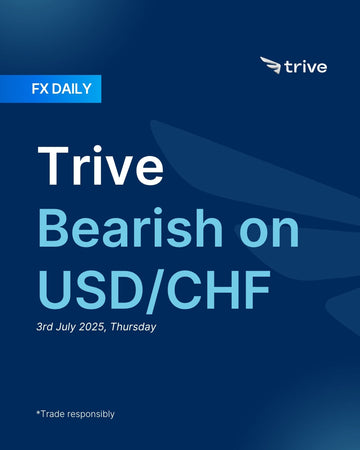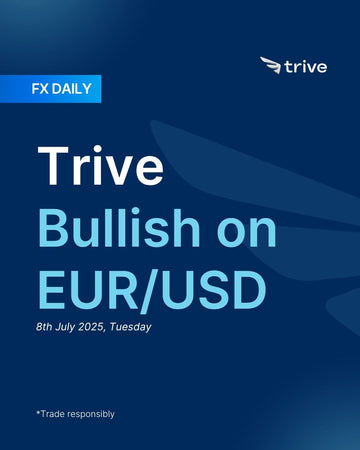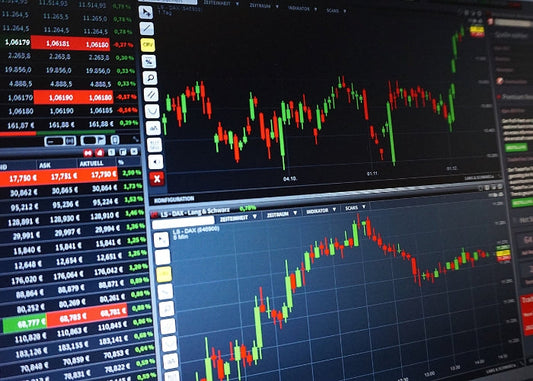FX Weekly: Trive’s Week Ahead Views

This week highlights include US President Trump's trade negotiation deadlines, minutes from the FOMC, rate decisions from RBA, RBNZ and BoK, while UK GDP and the Canadian Jobs Report will also be in focus.
Monday
Focus on Monday turns to industrial and consumer data from Europe and the US. Germany’s May industrial output follows weaker-than-expected factory orders (-1.6% M/M), suggesting risks to the headline print. Meanwhile, Sweden’s CPIF flash for June comes after May’s cooling to 2.3% Y/Y, undershooting expectations and reinforcing the Riksbank’s June rate cut. While another move this year is possible, the central bank remains data-dependent, and June’s release will be scrutinized for signs of Middle East-driven energy pass-through or spillover from global tariff pressures.
In the Eurozone, July’s Sentix investor sentiment will test whether June’s unexpected bounce to +5.2 continues amid easing financial conditions and mixed global growth signals. Retail sales for May could show further drag after April’s 0.5% decline. In the US, June’s Employment Trends Index may offer an early read on labor market momentum following a better-than-expected NFP report and will be relevant for gauging hiring appetite ahead of key inflation data later in the month.
Tuesday
Tuesday is policy-heavy, with both the RBA and RBNZ delivering decisions in Asia-Pacific. The RBA is widely expected to cut rates by 25bps to 3.60%, driven by subdued inflation (May Weighted CPI 2.1% Y/Y), weak jobs data (May employment -2.5k), and soft Q1 GDP. Governor Bullock has signaled scope for further easing, and although a 50bps move was previously discussed, a quarter-point cut is the base case. The statement will be watched for any changes to guidance amid escalating global trade uncertainty and volatile financial markets.
The RBNZ, in contrast, is expected to hold at 3.25%, following six consecutive cuts. The Q1 GDP beat and still-firm export sector provide room for a pause. Comments from Governor Hawkesby and Assistant Governor Silk suggest a data-dependent stance with no bias, reinforcing the sense that the OCR is now near neutral. Markets price a 75% chance of a hold, and forward guidance may be limited as the central bank assesses the impact of earlier easing.
Elsewhere, the EIA releases its July Short-Term Energy Outlook, which will be read in the context of the weekend’s OPEC+ decisions. German trade data for May and US NFIB small business optimism for June round out the calendar, the latter providing a window into sentiment among firms increasingly exposed to tariff and cost pressures.
Wednesday
A crucial day for global markets. The 90-day suspension on U.S. tariffs under the "Liberation Day" initiative ends, with new duties set to take effect. Trump has confirmed that 10-12 countries will receive tariff letters outlining levies from 10% to as high as 70%, while broader reciprocal tariffs on over 100 nations could hit 10% minimum. Treasury Secretary Bessent has indicated a flurry of deals may be announced to avoid escalation, but markets remain vulnerable to surprises. Analysts warn that despite apparent market complacency, failure to secure deals could unleash significant volatility across equities, FX, and rates.
In parallel, the EU-US tariff negotiation deadline looms. A 50% tariff is on the table if no agreement is reached. While Brussels seeks a 10% baseline in exchange for sector-specific relief, talks remain fraught, and an “agreement in principle” is possible to delay EU retaliation past the July 14th deadline. EU divisions—Germany and Italy pushing for compromise, while others remain cautious—add complexity. Risk assets, particularly industrials and exporters, will react sharply to any resolution—or lack thereof.
In Asia, Chinese June CPI and PPI are set to stay subdued. CPI is expected at 0% Y/Y, and PPI in deflation for a 33rd straight month at -3.1% Y/Y. ING notes persistent overcapacity and fierce price competition, prompting concern from policymakers. Any surprise uptick could shift expectations around stimulus, while continued deflation strengthens the case for further easing.
The June FOMC minutes will offer crucial insight into how firmly the Fed holds its patient stance. The June SEP signaled two cuts in 2025, but a growing minority now expects no change this year. Chair Powell emphasized uncertainty and patience at the press conference. The minutes will be parsed for any signs of internal debate, particularly amid firmer inflation data and solid labor prints that have caused markets to dial back expectations of a July move.
US May wholesale sales will provide an additional read on inventory and demand dynamics heading into Q3.
Thursday
The Bank of Korea meets Thursday, and while its dovish bias remains intact, markets lean toward a pause after May’s 25bps cut. Inflation ticked higher in June to 2.2% Y/Y (vs. expected 2.1%), but the BoK attributed the move to base effects. Governor Rhee previously noted room for more easing, but the bank may prefer to wait and assess the impact of earlier cuts, particularly with exports still soft and new leadership under President Lee Jae-myung just settling in. Global trade uncertainty also complicates the outlook.
Norway’s June CPI-ATE is expected to remain under close watch after May’s downside surprise helped justify a surprise rate cut. Norges Bank now forecasts CPI-ATE at 3.1% for June, slightly above its earlier projection but still consistent with continued easing into H2. Markets will scrutinize the print for upside risks that could derail guidance for one more cut this year.
In the US, weekly jobless claims will gauge whether softening in job openings and household employment is feeding into real-time claims activity. Elevated or declining claims will shape expectations for the July NFP and broader Fed policy timing.
China’s June monetary aggregates are due, with M2 and New Yuan Loans in focus. While typically lagging indicators, any surprise drop in lending could trigger fresh calls for PBOC action, especially amid persistent disinflation and weak credit demand.
Friday
Friday’s calendar ends with several key macro reads. In the UK, May GDP is expected to rebound 0.1% M/M following April’s 0.3% contraction. Pantheon sees support from a pickup in legal and real estate activity, while Investec forecasts a surprise -0.2% drop, citing weaker services and manufacturing data. With the MPC laser-focused on labor softness and persistent inflation, a soft GDP print could tilt expectations further toward an August cut.
Canada’s June jobs report takes center stage for the BoC outlook. With policymakers now operating without explicit forward guidance, labor data will be pivotal. Unemployment hit 6.9%, and the BoC warns of export-sensitive industries slashing hiring due to US tariffs. Another weak print could shift markets to price in a second cut before year-end, with broader implications for CAD and local rates.
The IEA's Monthly Oil Market Report will also be key following OPEC+’s decision on Saturday and the EIA STEO earlier in the week. Traders will look for updates on global supply-demand balances, inventory trends, and forward-looking guidance on H2 crude dynamics amid geopolitical risk and rising US output.
Disclaimer
This material is provided for informational purposes only and does not constitute financial, investment, or other advice. The opinions expressed in this material are those of the author and do not necessarily reflect the views of Trive International. No opinion contained in this material constitutes a recommendation by Trive International or its author regarding any particular investment, transaction, or investment strategy. This material should not be relied upon in making any investment decision.
The information provided does not consider the individual investment objectives, financial situation, or needs of any specific investor. Investors should seek independent financial advice tailored to their individual circumstances before making any investment decisions. Trive International shall not be liable for any loss, damage, or injury arising directly or indirectly from the use of this information or from any action or decision taken as a result of using this material.
Trive International may or may not have a financial interest in the companies or securities mentioned. The value of investments may fluctuate, and investors may not get back the amount they originally invested. Past performance is not indicative of future results.
For more information about Trive International, please visit http://trive.com/int
Additional Information
Investing involves risk, including the potential loss of principal. Diversification and asset allocation strategies do not ensure a profit or guarantee against loss. The content in this material is subject to change without notice and may become outdated or inaccurate over time. Trive International does not undertake any obligation to update the information in this material.
By accessing this material, you acknowledge and agree to the terms of this disclaimer. If you do not agree with these terms, please refrain from using this information.
No comments
Home
Trive
TriveHub





0 comments